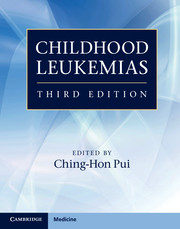Book contents
- Frontmatter
- Contents
- List of contributors
- Preface
- Section 1 History and general issues
- Section 2 Cell biology and pathobiology
- Section 3 Evaluation and treatment
- 12 Pharmacokinetic, pharmacodynamic, and pharmacogenetic considerations
- 13 Acute lymphoblastic leukemia
- 14 Relapsed acute lymphoblastic leukemia
- 15 B-cell acute lymphoblastic leukemia and Burkitt lymphoma
- 16 Acute myeloid leukemia
- 17 Relapsed acute myeloid leukemia
- 18 Myelodysplastic syndrome
- 19 Chronic myeloproliferative disorders
- 20 Leukemias in patients with Down syndrome
- 21 Treatment of adolescents and young adults with acute lymphoblastic leukemia
- 22 Hematopoietic stem cell and natural killer cell transplantation
- 23 Treatment of acute leukemia in countries with limited resources
- 24 Antibody-targeted therapy
- 25 Adoptive cellular immunotherapy
- 26 Gene transfer: methods and applications
- 27 Development therapeutics
- 28 Minimal residual disease
- Section 4 Complications and supportive care
- Index
- Plate Section
- References
19 - Chronic myeloproliferative disorders
from Section 3 - Evaluation and treatment
Published online by Cambridge University Press: 05 April 2013
- Frontmatter
- Contents
- List of contributors
- Preface
- Section 1 History and general issues
- Section 2 Cell biology and pathobiology
- Section 3 Evaluation and treatment
- 12 Pharmacokinetic, pharmacodynamic, and pharmacogenetic considerations
- 13 Acute lymphoblastic leukemia
- 14 Relapsed acute lymphoblastic leukemia
- 15 B-cell acute lymphoblastic leukemia and Burkitt lymphoma
- 16 Acute myeloid leukemia
- 17 Relapsed acute myeloid leukemia
- 18 Myelodysplastic syndrome
- 19 Chronic myeloproliferative disorders
- 20 Leukemias in patients with Down syndrome
- 21 Treatment of adolescents and young adults with acute lymphoblastic leukemia
- 22 Hematopoietic stem cell and natural killer cell transplantation
- 23 Treatment of acute leukemia in countries with limited resources
- 24 Antibody-targeted therapy
- 25 Adoptive cellular immunotherapy
- 26 Gene transfer: methods and applications
- 27 Development therapeutics
- 28 Minimal residual disease
- Section 4 Complications and supportive care
- Index
- Plate Section
- References
Summary
Introduction
In 1951, Dameshek first speculated that different chronic proliferative disorders share similar clinical and hematologic features and that patients with one of these diseases often develop, during the course of their illness, symptoms more typical of another disease, usually more severe than the original one. He coined the term “myeloproliferative disorders” (MPD) for these, now widely recognized, clonal proliferations of an abnormal hematopoietic stem cell. This group of related diseases, characterized by a variable propensity to evolve into acute leukemia, included chronic myeloid leukemia (CML), polycythemia vera (PV), essential thrombocythemia (ET) and primary myelofibrosis (PMF).
Myeloid neoplasms that present with aberrant proliferative and dysplastic features have raised considerable controversy with respect to their classification. The classification of MPDs by the World Health Organization (WHO) in 2001 separated these diseases into several myelodysplastic/myeloproliferative groups, including juvenile myelomonocytic leukemia (JMML), chronic myelomonocytic leukemia (CMML), atypical CML, and a group of otherwise unclassifiable diseases. While JMML represents approximately 2 to 3% of leukemias in children, CMML and atypical CML are extremely rare in young people. Occasionally, CMML is diagnosed in an adolescent with persistent monocytosis, low blast count, and the absence of genetic features of JMML or CML. In addition, a CMML-like morphology accompanied by hepatosplenomegaly may be observed in secondary hematopoietic neoplasms, following chemo- or radiotherapy for a first cancer.
- Type
- Chapter
- Information
- Childhood Leukemias , pp. 444 - 502Publisher: Cambridge University PressPrint publication year: 2012
References
- 3
- Cited by



